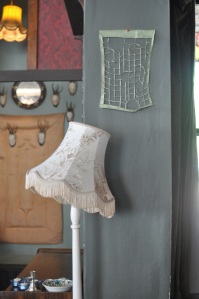What is the significance of working with Chinese practice paper rather than, say, the lines that guide written English and do you see the two languages conversing in any way within your work?
My choice of materials is guided by a sense of what feels natural to me and by a sense of visual excitement. When I first saw this paper, I knew I’d be able to do something with it but wasn’t sure what, so it lay around in the studio for quite a long time.
I did not learn to write Chinese characters, apart from childhood attempts to write my name and a few other words, until I studied Chinese at university, when I would spend hours writing characters over and over again as a way of committing them to memory. The link between repeated gesture and memory is very strong and Chinese characters can’t be remembered purely through the visual.
So the use of the paper is culturally meaningful for me and has autobiographical significance. It has taken me a long time to find a sense of ‘wholeness’ through my work, having been brought up to think of academia and art as separate things and to think of myself as being in two halves: Chinese/English.
The significance is less about two languages converging and more a subliminal bringing together of a split subjectivity. At the same time, the grid is the minimalist structure so it works well within a fine art context. I like the fact too that the gridlines are imperfectly printed, which betrays a certain hand-madeness at their origin.
You cut out or fill, often with lines, the space within the grids where, if used for their intended purpose, Chinese characters would be practiced. Why did you choose to work with these spaces in this way?
At some level my work is about a desire to make perfect, to fit, so there is a link with the idea of practice as a repetitive action – a rehearsal. But what is repeated is never duplicated. The nature of practicing something is intrinsically about repetition, which in turn has a ritualistic, meditative effect and opens up space in the mind. Repetition also relates to trauma, loss, fragility.
The marks I make are to a certain degree very basic ones: just lines and deliberately not overtly gestural in a big expressive way. There is something about working within the grid which makes for slowness, which contains the gestural, which works against the idea of the heroic mark.
By cutting into the grid, the paper becomes more fragile and the grid itself less rigid and more mesh-like. Often the grid will tear to the point of collapse, which is what happens in life: we build structures, put things in boxes, try to separate this from that but it is a hopeless task.
At the same time, cutting out the squares creates empty spaces, spaces of possibility and of non-meaning, which relates back to the non-writing. What is removed is often blank paper, so maybe this is about blankness, pointlessness, futility.
And yet, some of the gridlines remain and still frame the space revealed, allowing for suggested narratives.
http://www.studio308ltd.co.uk
https://twitter.com/#!/ClareGSmith
Facebook page: https://www.facebook.com/pages/Clare-Smith-artist/287642764614592


